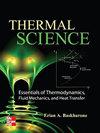内峰角和质量流量对三角截面太阳能空气加热器热性能影响的CFD分析
IF 1.1
4区 工程技术
Q4 THERMODYNAMICS
引用次数: 1
摘要
对一种新型三角形截面太阳能空气加热器进行了数值研究。研究了不同质量流量、进口空气温度和太阳辐照强度下SAH的热性能。利用ANSYS Fluent软件建立CFD模型。研究了太阳能空气加热器内的流体流动和传热特性。采用三维离散方法研究了三角形截面太阳能集热器的热性能。网格独立性是为了选择合适的网格。离散坐标辐射模型(DOM)和RNG k-?湍流模型用于研究SAH内部的辐射换热和湍流流动。特别是,不同的内峰角(145°,126°)的影响, 100 ?, 80 ?研究了不同太阳辐照强度(620W/m^2 ~ 1081W/m^2)下SAH的热性能。结果表明,数值模型与实验数据吻合较好,平均误差为6%。南海最高出风口温度达到72?C为12和16通道的几何形状(内部峰值角为80?和67.5吗?),质量流量为0.0264kg/s。当太阳辐照强度为1081 W/m^2时,16通道和12通道的SAH的热性能分别比标准几何形状高24.2%。内峰角为80的构型?12通道被选为最优,热效率为79%,与16通道相比,压力降低,成本更低。本文章由计算机程序翻译,如有差异,请以英文原文为准。
CFD analysis of the effect of internal peak angle and mass flow rates on the thermal performance of solar air heater with triangle cross-section
A new design of Solar Air Heater (SAH) with triangle cross-section is numerically studied. The thermal performance of SAH is studied at various mass flow rates, inlet air temperatures and solar irradiation intensities. The CFD model is developed using the software ?ANSYS Fluent? to study the fluid flow and heat transfer in the solar air heater. 3D discretization is applied to study the thermal performance of solar collector with triangle cross section. Mesh independence is performed in order to choose the adequate mesh. The discrete ordinate radiation model (DOM) and the RNG k-? turbulence model are used to study the radiative heat transfer and the turbulent flow inside the SAH. Particularly, effects of different internal peak angles (145?,126?, 100?, 80? and 67.5?) under different solar irradiation intensities (from 620W/m^2 to 1081W/m^2) are studied to improve the thermal performance of the SAH. The results show a good agreement between the numerical model and the experimental data with an average error of 6%. The maximum outlet air temperature of the SAH reached 72?C for the geometries with 12 and 16 channels (Internal peak angles of 80? and 67.5?, respectively) under mass flow rate of 0.0264kg/s. The thermal performances of the SAH with 16 and 12 channels are 24.2% higher than standard geometry, respectively for solar irradiation intensity of 1081 W/m^2. The configuration with internal peak angle of 80? and 12 channels is selected as the optimal with a thermal efficiency of 79%, a low pressure drops compared to geometry with 16 channels and lower costs.
求助全文
通过发布文献求助,成功后即可免费获取论文全文。
去求助
来源期刊

Thermal Science
工程技术-热力学
CiteScore
2.70
自引率
29.40%
发文量
399
审稿时长
5 months
期刊介绍:
The main aims of Thermal Science
to publish papers giving results of the fundamental and applied research in different, but closely connected fields:
fluid mechanics (mainly turbulent flows), heat transfer, mass transfer, combustion and chemical processes
in single, and specifically in multi-phase and multi-component flows
in high-temperature chemically reacting flows
processes present in thermal engineering, energy generating or consuming equipment, process and chemical engineering equipment and devices, ecological engineering,
The important characteristic of the journal is the orientation to the fundamental results of the investigations of different physical and chemical processes, always jointly present in real conditions, and their mutual influence. To publish papers written by experts from different fields: mechanical engineering, chemical engineering, fluid dynamics, thermodynamics and related fields. To inform international scientific community about the recent, and most prominent fundamental results achieved in the South-East European region, and particularly in Serbia, and - vice versa - to inform the scientific community from South-East European Region about recent fundamental and applied scientific achievements in developed countries, serving as a basis for technology development. To achieve international standards of the published papers, by the engagement of experts from different countries in the International Advisory board.
 求助内容:
求助内容: 应助结果提醒方式:
应助结果提醒方式:


